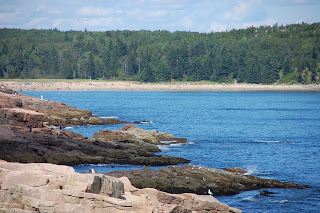We've fallen in love with Acadia Park! It's the oldest park east of the Mississippi, established by Teddy Roosevelt in 1919. The glacier-carved island on which most of Acadia is situated was a tourist mecca as early as the 1850s (the public was drawn here by the paintings of landscape artists). By the late part of that century, it had become a favorite summer spot of some of America's wealthiest families: Rockefellers, Morgans, Fords, Astors, Vanderbilts and Pulitzers. All bought sizeable chunks of land and built "cottages," 30+-room mansions for the use of their family and friends. In 1901, some of these same people joined with locals who, concerned about the growing commericialization of the island, formed a land trust to protect it from uncontrolled development. The group worked to purchase and thereby preserve parcels of land, maintaining it for public use, and donated much of their private holdings to the trust.
By 1916, the parcels had secured the status of National Monument and, in 1919, gained National Park status. It was called Lafayette Park in those early years, in recognition of the land's French heritage; the region was a French claim prior to that country's loss to the British in the 7 Years War (aka French and Indian War). What for centuries had been known as New France suddenly became New England! Fast forward to the 1950s; a British family that owned the adjacent Schoodic Peninsula wished to donate it to the park, but the gift came with one stipulation: change the French name. The park superintendent pushed through a new name, requiring an act of Congress to do so. Unobjectionable "Acadia" is believed to be a Wabanaki Indian word.
One of the largest land donors was J.D.Rockeller, Jr, who donated more than 10,000 acres. He's also loved for having built more than 45 miles of carriage roads beginning in 1913; smooth and scenic, these single-lane roads (which were designed with no more than 150 yards in between a turn or a hill, so that the next bit of road is always new and surprising) were off-limits to automobiles and connected by 17 stone bridges. When cars were eventually allowed in the park, auto roads were created with the same care, and on different paths than the carriage roads. Those carriage roads are still used by horse-drawn carriages, which share them with bicycles and walkers.
Most of these historical nuggets were gleaned on a ranger-led tour of the Cliff Path, a two-hour hike this afternoon with Ranger Kim on the eastern coastal rocks. Afterward, we took in an elegant Acadia tradition: tea and popovers at the Jordan Pond House. The restaurant sits in a glacier-carved valley overlooking the "pond"--really a large, beautiful lake--and feasted on the homemade popovers, for which the place is famous. The goodies are considered fresh for only 15 minutes; at that point, any still sitting around are put into the slop pile and donated to local pigs. Lucky beasts! The place serves upwards of 5,000 popovers per day (to 2,000 patrons...you do the math). We're motivated to download the recipe when we get home and try to replicate the experience--an impossible goal.
We're planning a surprise carriage ride for tomorrow afternoon...the girls won't sleep with excitement if we tell them tonight. And they'll need every minute of sleep they can get, as we intend to wake them at 4am and drive to the summit of Cadillac Mountain within the park, the tallest point on the entire eastern coast, and be the first people in the U.S. to see the sunrise! We'll see how strong our motivation is when the alarm rings. :-) With that thought in mind, we'll sign off for tonight and find our pillows.
 |
| Upon our arrival yesterday evening, we walked down to the bay (this is 50 yards from our camper!) and checked out the scene at low tide. Acadia is in the background. |
 |
| The girls were less-than-enthusiastic about our lobster dinner last night. They were happy to stick with their broccoli and pasta. |
 |
| Morning fog on the bay |
 |
| At the summit of Cadillac Mountain |
 |
| Near Thunder Hole (it roars as the tide comes in) |
 |
| One of the 17 bridges in the system of carriage roads |

 |
| Sand Beach, in the distance, is scoured clear of sand by winter storms. Spring currents redeposit it. Amazing! |









No comments:
Post a Comment